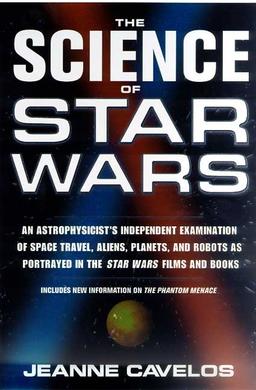The Fermi paradox is the discrepancy between the lack of conclusive evidence of advanced extraterrestrial life compared to the apparently high a priori likelihood of its existence. As a 2015 article put it, "If life is so easy, someone from somewhere must have come calling by now."
The technology in Star Trek has borrowed many ideas from the scientific world. Episodes often contain technologies named after real-world scientific phenomena, such as tachyon beams, baryon sweeps, quantum slipstream drives, and photon torpedoes. Some of the technologies created for the Star Trek universe were done so out of financial necessity. For instance, the transporter was created because the limited budget of Star Trek: The Original Series (TOS) in the 1960s did not allow expensive shots of spaceships landing on planets.

A transporter is a fictional teleportation machine used in the Star Trek science fiction franchise. Transporters allow for teleportation by converting a person or object into an energy pattern, then sending ("beaming") it to a target location or else returning it to the transporter, where it is reconverted into matter ("rematerialization"). Since its introduction in Star Trek: The Original Series in 1966, the name and similar concepts have made their way to other science fiction scenarios, in literature, games (SimEarth), etc.

A warp drive or a drive enabling space warp is a fictional superluminal spacecraft propulsion system in many science fiction works, most notably Star Trek, and a subject of ongoing physics research. The general concept of "warp drive" was introduced by John W. Campbell in his 1957 novel Islands of Space and was popularized by the Star Trek series. Its closest real-life equivalent is the Alcubierre drive, a theoretical solution of the field equations of general relativity.

A starship, starcraft, or interstellar spacecraft is a theoretical spacecraft designed for traveling between planetary systems.

Michio Kaku is an American theoretical physicist, futurist, and popularizer of science. He is a professor of theoretical physics in the City College of New York and CUNY Graduate Center. Kaku is the author of several books about physics and related topics and has made frequent appearances on radio, television, and film. He is also a regular contributor to his own blog, as well as other popular media outlets. For his efforts to bridge science and science fiction, he is a 2021 Sir Arthur Clarke Lifetime Achievement Awardee.

"Where no man has gone before" is a phrase made popular through its use in the title sequence of the original 1966–1969 Star Trek science fiction television series, describing the mission of the starship Enterprise. The complete introductory speech, spoken by William Shatner as Captain James T. Kirk at the beginning of each episode, is:
Space: the final frontier. These are the voyages of the starship Enterprise. Its five-year mission: to explore strange new worlds. To seek out new life and new civilizations. To boldly go where no man has gone before!

CTV Sci-Fi Channel is a Canadian English language specialty channel owned by Bell Media. The channel primarily broadcasts speculative fiction and related programming.

Lawrence Maxwell Krauss is an American theoretical physicist and cosmologist who previously taught at Arizona State University, Yale University, and Case Western Reserve University. He founded ASU's Origins Project, now called ASU Interplanetary Initiative, to investigate fundamental questions about the universe and served as the project's director.

Mundane science fiction (MSF) is a niche literary movement within science fiction that developed in the early 2000s, with principles codified by the "Mundane Manifesto" in 2004, signed by author Geoff Ryman and "The Clarion West 2004 Class". The movement proposes "mundane science fiction" as its own subgenre of science fiction, typically characterized by its setting on Earth or within the Solar System; a lack of interstellar travel, intergalactic travel or human contact with extraterrestrials; and a believable use of technology and science as it exists at the time the story is written or a plausible extension of existing technology. There is debate over the boundaries of MSF and over which works can be considered canonical. Rudy Rucker has noted MSF's similarities to hard science fiction and Ritch Calvin has pointed out MSF's similarities to cyberpunk. Some commentators have identified science fiction films and television series which embody the MSF ethos of near-future realism.

The Physics of Star Trek is a 1995 non-fiction book by the theoretical physicist Lawrence M. Krauss. It is the third book by Krauss, who later wrote a follow-up titled Beyond Star Trek in 1997.
How William Shatner Changed the World is a 2005 two-hour television documentary, commissioned by Discovery Channel Canada and co-produced for History Channel in the United States and Channel Five in the United Kingdom. Hosted and narrated by William Shatner, known for his portrayal of Captain James T. Kirk, and based on his 2002 book, I'm Working on That, the show focuses on technological advancements and people in the real world that were inspired by the Star Trek phenomenon.

Physics of the Impossible: A Scientific Exploration Into the World of Phasers, Force Fields, Teleportation, and Time Travel is a book by theoretical physicist Michio Kaku. Kaku uses discussion of speculative technologies to introduce topics of fundamental physics to the reader. The topic of invisibility becomes a discussion on why the speed of light is slower in water than in vacuum, that electromagnetism is similar to ripples in a pond, and Kaku discusses newly developed composite materials. The topic of Star Trek "phasers" becomes a lesson on how lasers work and how laser-based research is conducted. The cover of his book depicts a TARDIS, a device used in the British science fiction television show Doctor Who to travel in space and time, in its disguise as a police box, continuously passing through a time loop. With each discussion of science fiction technology topics he also "explains the hurdles to realizing these science fiction concepts as reality".

The Science of Star Wars is a nonfiction popular science book written by former NASA astrophysicist Jeanne Cavelos first published on April 15, 1999, by St. Martin's Press. The book uses fictional characters, worlds, and technology from the Star Wars universe as starting points for discussion of factual concepts in cosmology, biology, and technology, and discusses in a "semi-serious" fashion the scientific probability of such fictional elements. "It takes the fantastic elements of the movies—like faster-than-light travel—and examines the current state of science to see if they're possible".

Hiding in the Mirror is a popular science book by the theoretical physicist Lawrence M. Krauss. The text was initially published on October 20, 2005 by Viking Press. This is his seventh non-fiction book.

Atom: An Odyssey from the Big Bang to Life on Earth...and Beyond is the sixth non-fiction book by the American theoretical physicist Lawrence M. Krauss. The text was published on April 1, 2001 by Little, Brown. Krauss won the Science Writing Award (2002) for this book.

Quintessence: The Search for Missing Mass in the Universe is the fifth non-fiction book by the American theoretical physicist Lawrence M. Krauss. The book was published by Basic Books on December 21, 2000. This text is an update of his 1989 book The Fifth Essence. It was retitled Quintessence after the now widely accepted term for dark energy.

The Greatest Story Ever Told—So Far: Why Are We Here? is the tenth full-length non-fiction book by the American theoretical physicist Lawrence M. Krauss. The book was initially published on March 21, 2017 by Atria Books.

Alex White is an American author of science fiction and horror. They are best known for The Salvagers trilogy and their tie-in novels for the Alien and Star Trek franchises. White uses singular they pronouns.
METI International, known simply as METI, is a non-profit research organization founded in July 2015 by Douglas Vakoch that creates and transmits interstellar messages to attempt to communicate with extraterrestrial civilizations. It is based in San Francisco, California.
















